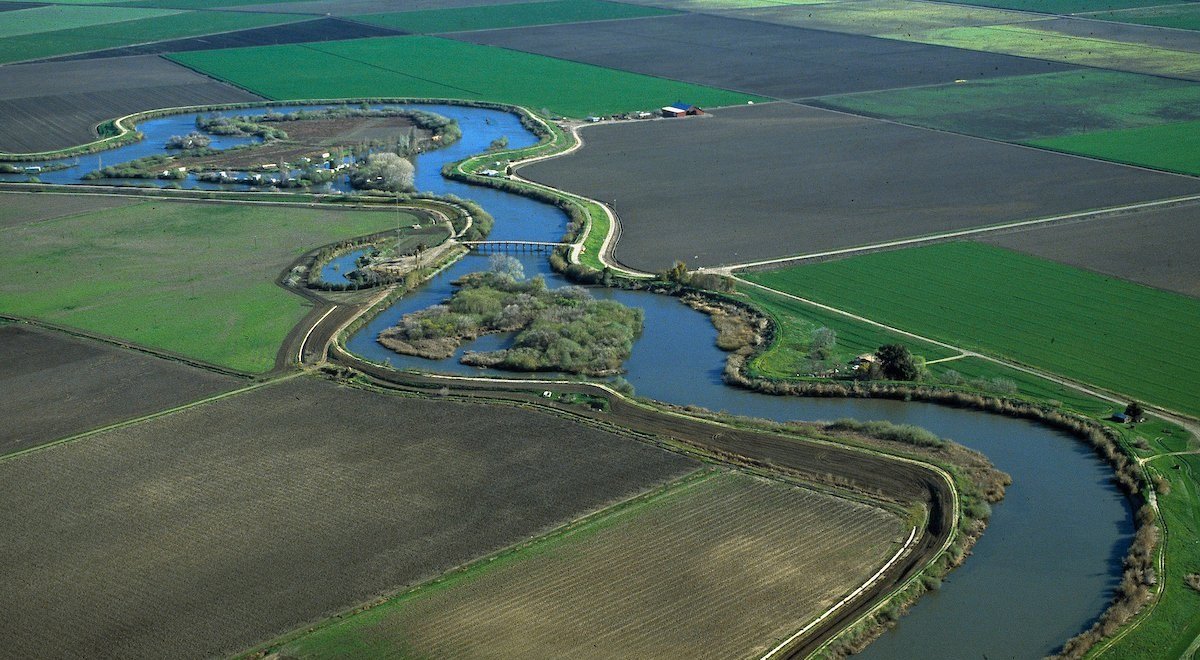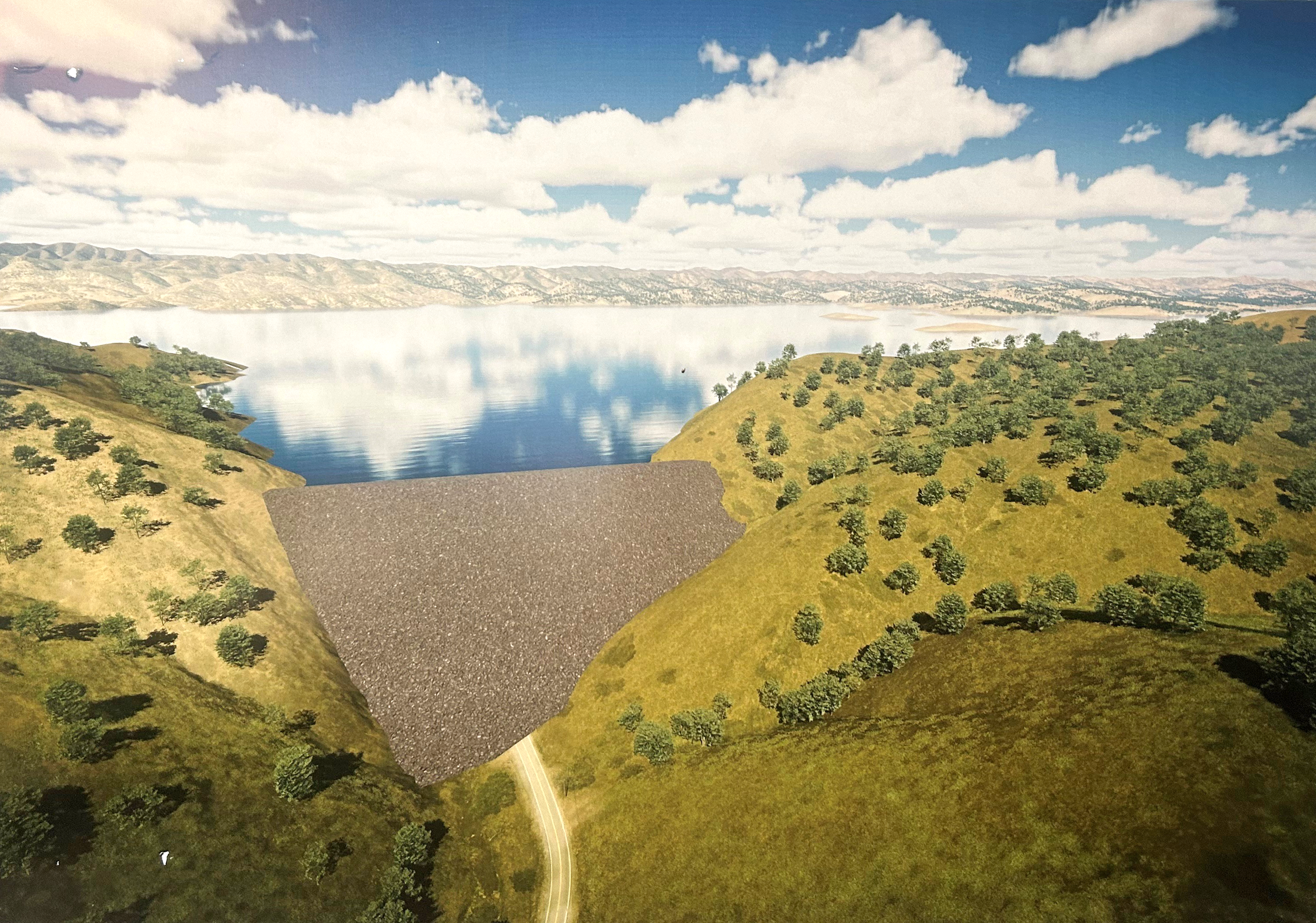It Ain’t Over Until the Fat Lady Issues a Permit, or Three
A Delta waterway transects Delta farmlands. Credit: Paul Hames, CA Dept. of Water Resources.
Delta Tunnel Moves Ahead in State Proceeding, Joining Sites Reservoir and VAs to Form “Triple Threat”
Like Jack Nicholson axing his way through the door to announce that he’s home in “The Shining,” the Delta Conveyance Project – aka the Delta Tunnel, nee the Peripheral Canal – has returned to once again threaten the health of California’s rivers and the San Francisco Bay-Delta estuary.
The State Water Resources Control Board’s Administrative Hearings Office (AHO) will begin the evidentiary phase of its water rights proceeding on March 24. This proceeding will determine whether to permit the construction and operation of the latest version of the proposed project that would take Sacramento River water from the North Delta, and then export that water (in this case, through a new tunnel) to the massive State Water Project pumps in the South Delta. (The canal version, originally proposed as part of the SWP infrastructure in the 1950s and 1960s, was rejected by voters in 1982).
The Department of Water Resources will make its case to build the Tunnel (also called its “case in chief”) over the spring months, and the many parties that have formally “protested” DWR’s petition are scheduled to make their counterarguments against the Tunnel starting this July. Both cases in chief will be presented and subject to cross examination in a quasi-judicial format presided over by the AHO. Friends of the River filed a formal protest(1) against the project along with Sierra Club California, Center for Biological Diversity, Planning and Conservation League, Save California Salmon, and the North Coast Rivers Alliance, and is also working closely with the Delta Tribal Environmental Coalition and others.
The tiny Delta smelt — once the most abundant fish in the Bay-Delta and now barely persisting in the wild, is an indicator of ecological collapse.
There are many reasons to oppose the Tunnel project, but perhaps the most critical is the fundamental question of how much water can safely be diverted from the estuary and its watershed without undermining its ability to provide a broad array of ecosystem services to society, fish, and wildlife. The overwhelming scientific evidence is that current water diversion levels are extremely harmful, with water quality threatened by toxic algal blooms and many native species at record or near record low levels, and therefore new, more protective requirements to increase freshwater flow from rivers to and through the Delta to San Francisco Bay are desperately needed.
Many of the protestants have requested that the Tunnel proceeding be put on hold until the State Water Board has completed its long-delayed update of water quality regulations in the Bay-Delta Plan, which if done correctly should set the boundaries for sustainable yield of water from the system.
Equally problematic is the fact that no one is sure how much water DWR would be entitled to move through the Tunnel even if it is permitted and constructed. Either DWR is limited to the amount of water it was able to divert before its underlying permits for beneficial use of water expired in 2009, or it may increase its diversions based on the assumption that future approval of an extended deadline will allow the additional capacity provided by the Tunnel to be used. The answer to this question – and the environmental, sociocultural, and economic impacts associated with the project – changes dramatically depending on which scenario is assumed.
Further complicating the issue is that DWR has thus far failed to respond to the AHO’s demand that it identify the maximum amount of water diverted to storage and exported from the Delta in any year before 2010. Given the lack of this information and the very different implications of the two scenarios, many protestants are opposed to the AHO’s dual scenario approach and are requesting that these fundamental outstanding issues be resolved before the proceedings continue.
Permitting the Delta Tunnel is only one part of a larger plan by the Newsom Administration to transform California water management, and not for the better. In order to justify the huge projected cost of the Tunnel project, even more Sacramento River water would have to be captured in the proposed Sites Reservoir in the western Sacramento Valley and then sold under transfer agreements or delivered under contract for rediversion from the Delta.
Rendering of the proposed Sites Reservoir. Credit: Sites Project Authority.
Proposed Sites Reservoir Water Rights Proceeding Nears Conclusion—What Comes Next?
While the water rights proceedings for the Delta Tunnel are ramping up, the water rights proceedings for the proposed Sites Reservoir are nearing the offramp, but questions remain about its value to the people of California.
Sites Reservoir is a proposed reservoir that would be located near Colusa, California. Although it would have a total storage capacity of 1.5 million acre-feet, making it one of the largest water storage facilities in the state, it would only add less than 1% to California’s water budget in an average year, based on best case estimates(2). Worst case estimates show that it would add only a tenth of 1%.
Such little water—but at what cost? Sites would cost taxpayers and ratepayers nearly $5 billion at current prices (the real number will certainly be much higher due to inflation during the long runup to construction, and other costs). Additional diversions from the Sacramento River would further stress an overburdened and overallocated water system. Reducing Sacramento River flows will harm water quality, increase native species extinction risk, impact fishing communities, and limit the access of Californians to the natural and cultural resources of a living river system.
A native flower species, P. tanacetifolia, near the proposed location of Sites Reservoir. Credit: Greg Kareofelas
Tuesday, March 11 was the last day of the evidentiary portion of the Sites water rights hearing. Protestants and other parties to the proceeding will have until late May (date TBA) to file final briefs to the Administrative Hearings Office. The AHO will then issue a draft Proposed Order regarding the water rights application, which will either deny the permit, or approve it with conditions (limitation on diversions and operations). The Proposed Order will be open for public comment, revised, and then the State Water Resources Control Board will vote on whether or not to approve it. We expect the entire process will be complete by early- to mid-2026.
The proceeding will ultimately determine how much water Sites can legally divert, but this decision comes amid broader concerns about the state’s failure to adopt new, science-based water quality standards for the Delta.
Sandhill cranes are prominent migratory birds that rely on the Bay-Delta for habitat during the winter. Credit: Florence Low, CA Depr. of Water Resources, 2014.
A Sweetheart Deal for the Largest Water Users in the State – The Voluntary Agreements
The final part of the scheme – to capture more water in Sites and transfer it through the Delta Tunnel – relies on replacing long-overdue, critical water quality standards with proposed “Voluntary Agreements” (VAs). These agreements, negotiated between water districts and the Newsom Administration, would allow even more Delta water exports, despite already unsustainable levels. It’s no coincidence that the largest water retailer in the state—the Metropolitan Water District of Southern California—is a major supporter of both Sites Reservoir and the Delta Tunnel.
The State Water Board, under immense political pressure, is considering the VAs in lieu of strong, proactive regulations which would prevent further collapse of Bay-Delta native fish populations and the decline of ecosystem functions. To make matters worse, the water districts and administration leaders behind the VAs are pushing back against even having a regulatory backstop in place in case their voluntary agreements fall apart, or fail to protect water quality.
After delaying the standard setting process for years, Governor Newsom is now pushing for the Board to approve the VAs (known in true Orwellian style as “Healthy Rivers and Landscapes”), Sites, and the Tunnel all within the next year or so. The governor treats the Board like his own fiefdom, but the fact is that it’s an independent agency. Given all that’s at stake, this is the time for State Water Board to remember that fact, and remember that the public, not the administration, is their ultimate client when choosing between decisions that preserve our state’s precious ecological and cultural resources – or maintain the current, unsustainable over-extraction of those resources.





